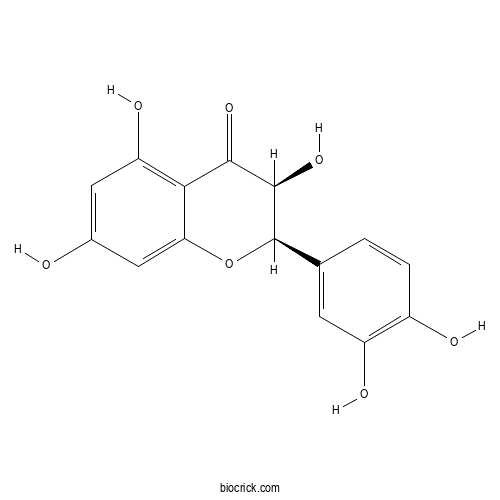(-)-EpitaxifolinCAS# 114761-89-6 |

- (-)-Dihydroquercetin
Catalog No.:BCN3370
CAS No.:111003-33-9
- (+)-Taxifolin
Catalog No.:BCN5972
CAS No.:17654-26-1
- Taxifolin
Catalog No.:BCN5550
CAS No.:480-18-2
- (+)-Epitaxifolin
Catalog No.:BCX1062
CAS No.:153666-25-2
- (±)-Taxifolin
Catalog No.:BCX1482
CAS No.:24198-97-8
Quality Control & MSDS
3D structure
Package In Stock
Number of papers citing our products

| Cas No. | 114761-89-6 | SDF | Download SDF |
| PubChem ID | 712318.0 | Appearance | Powder |
| Formula | C15H12O7 | M.Wt | 304.25 |
| Type of Compound | Flavonones | Storage | Desiccate at -20°C |
| Solubility | Soluble in Chloroform,Dichloromethane,Ethyl Acetate,DMSO,Acetone,etc. | ||
| Chemical Name | (2R,3S)-2-(3,4-dihydroxyphenyl)-3,5,7-trihydroxy-2,3-dihydrochromen-4-one | ||
| SMILES | C1=CC(=C(C=C1C2C(C(=O)C3=C(C=C(C=C3O2)O)O)O)O)O | ||
| Standard InChIKey | CXQWRCVTCMQVQX-HUUCEWRRSA-N | ||
| Standard InChI | InChI=1S/C15H12O7/c16-7-4-10(19)12-11(5-7)22-15(14(21)13(12)20)6-1-2-8(17)9(18)3-6/h1-5,14-19,21H/t14-,15-/m1/s1 | ||
| General tips | For obtaining a higher solubility , please warm the tube at 37 ℃ and shake it in the ultrasonic bath for a while.Stock solution can be stored below -20℃ for several months. We recommend that you prepare and use the solution on the same day. However, if the test schedule requires, the stock solutions can be prepared in advance, and the stock solution must be sealed and stored below -20℃. In general, the stock solution can be kept for several months. Before use, we recommend that you leave the vial at room temperature for at least an hour before opening it. |
||
| About Packaging | 1. The packaging of the product may be reversed during transportation, cause the high purity compounds to adhere to the neck or cap of the vial.Take the vail out of its packaging and shake gently until the compounds fall to the bottom of the vial. 2. For liquid products, please centrifuge at 500xg to gather the liquid to the bottom of the vial. 3. Try to avoid loss or contamination during the experiment. |
||
| Shipping Condition | Packaging according to customer requirements(5mg, 10mg, 20mg and more). Ship via FedEx, DHL, UPS, EMS or other couriers with RT, or blue ice upon request. | ||

(-)-Epitaxifolin Dilution Calculator

(-)-Epitaxifolin Molarity Calculator
| 1 mg | 5 mg | 10 mg | 20 mg | 25 mg | |
| 1 mM | 3.2868 mL | 16.4339 mL | 32.8677 mL | 65.7354 mL | 82.1693 mL |
| 5 mM | 0.6574 mL | 3.2868 mL | 6.5735 mL | 13.1471 mL | 16.4339 mL |
| 10 mM | 0.3287 mL | 1.6434 mL | 3.2868 mL | 6.5735 mL | 8.2169 mL |
| 50 mM | 0.0657 mL | 0.3287 mL | 0.6574 mL | 1.3147 mL | 1.6434 mL |
| 100 mM | 0.0329 mL | 0.1643 mL | 0.3287 mL | 0.6574 mL | 0.8217 mL |
| * Note: If you are in the process of experiment, it's necessary to make the dilution ratios of the samples. The dilution data above is only for reference. Normally, it's can get a better solubility within lower of Concentrations. | |||||

Calcutta University

University of Minnesota

University of Maryland School of Medicine

University of Illinois at Chicago

The Ohio State University

University of Zurich

Harvard University

Colorado State University

Auburn University

Yale University

Worcester Polytechnic Institute

Washington State University

Stanford University

University of Leipzig

Universidade da Beira Interior

The Institute of Cancer Research

Heidelberg University

University of Amsterdam

University of Auckland

TsingHua University

The University of Michigan

Miami University

DRURY University

Jilin University

Fudan University

Wuhan University

Sun Yat-sen University

Universite de Paris

Deemed University

Auckland University

The University of Tokyo

Korea University
- Zymosterol
Catalog No.:BCX1125
CAS No.:128-33-6
- Jaligonic acid B
Catalog No.:BCX1124
CAS No.:2375176-78-4
- Monensin B
Catalog No.:BCX1123
CAS No.:30485-16-6
- Beta-Tomatine
Catalog No.:BCX1122
CAS No.:17406-46-1
- Orchioside B
Catalog No.:BCX1121
CAS No.:851780-22-8
- Abyssinone II
Catalog No.:BCX1120
CAS No.:77263-08-2
- Sphingomyelin
Catalog No.:BCX1119
CAS No.:6254-89-3
- 22,23-Dihydroergosterol
Catalog No.:BCX1118
CAS No.:516-79-0
- Inflacoumarin A
Catalog No.:BCX1117
CAS No.:158446-33-4
- Strigolactone
Catalog No.:BCX1116
CAS No.:76974-79-3
- Steviol-13-O-Glucoside
Catalog No.:BCX1115
CAS No.:60129-60-4
- Nifedipine impurity B
Catalog No.:BCX1114
CAS No.:50428-14-3
- 2,3,4,6-tetraacetate Salidroside
Catalog No.:BCX1127
CAS No.:28251-63-0
- Salidroside pentaacetate
Catalog No.:BCX1128
CAS No.:39032-08-1
- Agigenin
Catalog No.:BCX1129
CAS No.:55332-76-8
- Ostruthine
Catalog No.:BCX1130
CAS No.:148-83-4
- L-Guluronic Acid Sodium Salt
Catalog No.:BCX1131
CAS No.:15769-56-9
- Tetraacetylphytosphingosine
Catalog No.:BCX1132
CAS No.:13018-48-9
- β-Sitosteryl acetate
Catalog No.:BCX1133
CAS No.:915-05-9
- 3-Feruloyl-4-caffeoylquinic acid
Catalog No.:BCX1134
CAS No.:96990-65-7
- Avenanthramide B
Catalog No.:BCX1135
CAS No.:108605-69-2
- Avenanthramide A
Catalog No.:BCX1136
CAS No.:108605-70-5
- Ganosporeric acid A
Catalog No.:BCX1137
CAS No.:135357-25-4
- N-methyltyramine
Catalog No.:BCX1138
CAS No.:370-98-9
Neuroprotective biflavonoids of Chamaecyparis obtusa leaves against glutamate-induced oxidative stress in HT22 hippocampal cells.[Pubmed:24315869]
Food Chem Toxicol. 2014 Feb;64:397-402.
Four biflavonoids (1-4), five flavonoids glycosides (5-9), two catechins (10, 11), two lignans (12-13), neolignan glycoside (14) and phenylpropanoid glycoside (15) were isolated from the leaves of Chamaecyparis obtusa (Cupressaceae). Neuroprotective effects of the isolated compounds were evaluated employing HT22 mouse hippocampal cells, a model system to study glutamate-induced oxidative stress. The glutamate injured HT22 cells were protected significantly by amentoflavone (3), ginkgetin (4) and (-)-Epitaxifolin 3-O-beta-D-xylopyranoside (9). The reduced activities of antioxidant enzymes, superoxide dismutase (SOD), glutathione reductase (GR) in response to high concentration of glutamate were preserved by pre-treatment of 3, 4 or 9, while the activities of glutathione peroxidase (Gpx) and catalase (CAT) were little affected. The reduced content of GSH induced by glutamate was also recovered by 3, 4 or 9 in accommodation with the decrease in ROS production. In addition, the phosphorylation of ERK1/2 induced by glutamate insult was clearly prevented by 3, while little changed by 4. Taken together, amentoflavone (3), ginkgetin (4) and (-)-Epitaxifolin 3-O-beta-D-xylopyranoside (9) derived from C. obtusa could protect HT22 neuronal cells against glutamate-induced oxidative damage through preserving antioxidant enzymes activities and/or inhibiting ERK1/2 activation.


